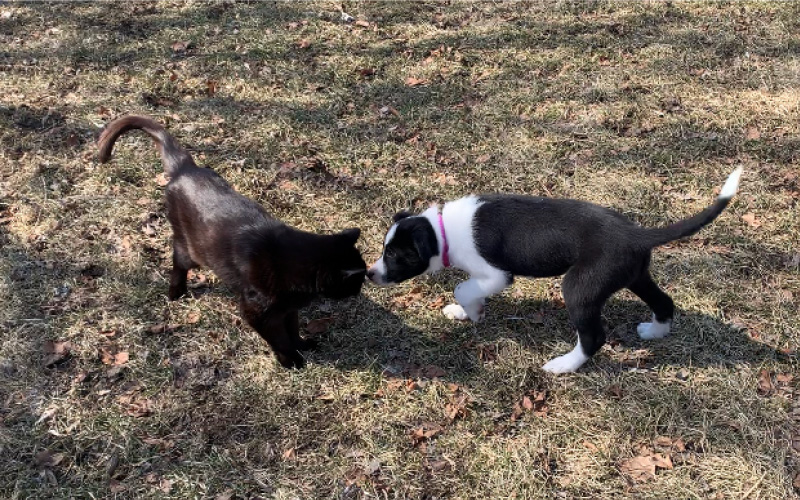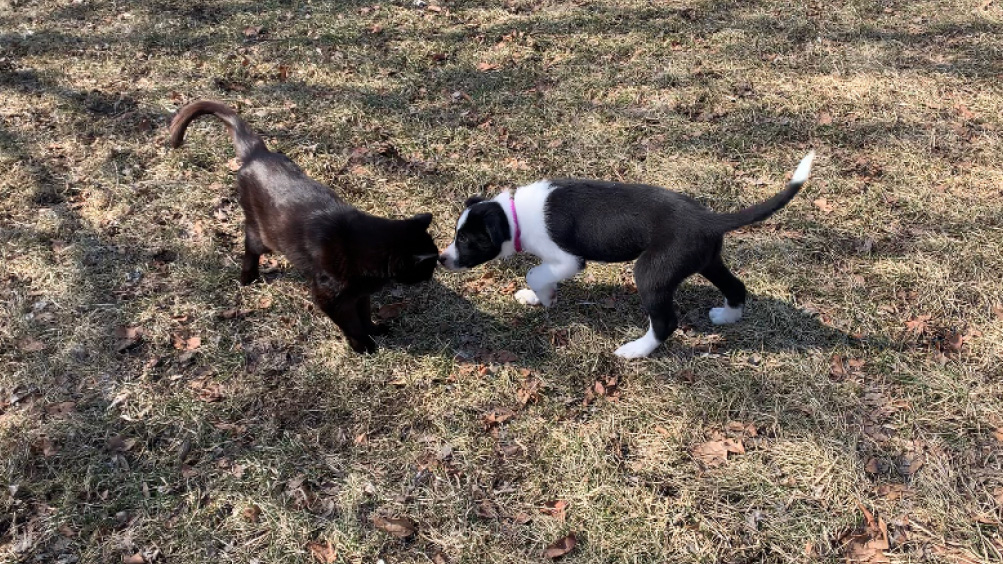
One of the best dog-training instructors I know has never kneed or pushed a dog for jumping up on her. It might surprise you to know that I have never heard her yell, “Don’t jump!” or “No.”
Now you must be thinking, “Oh, she’s one of those positive reinforcement trainers. She must give the dog a lot of treats. Like a PEZ dispenser.” I swear to you that this trainer never gives treats. Somehow, she has masterfully trained countless dogs in her 15 years.
That’s right, this trainer is only 15 years old. You’re probably wondering how a teenager learned to be such a successful dog trainer, right?
Well, it certainly helps to be the same species and share a native language. Ginger Peach is a 15-year-old Chow/Pit Bull mix. Her latest student is Marvel, a 10-week-old Border Collie. They are the oldest and youngest dogs in my pack of four dogs. I am fascinated by their daily interactions as Peachy patiently teaches Marvel, the obnoxious new kid on the block, how to be a civilized pup in our household.
Watch the video below. It’s a skilled lesson in teaching a dog “don’t jump,” and much more. How would you describe Peachy’s body language? Is she moving fast or staying stock still? Does she bark, growl or teeth chatter? Is she staring down the puppy or is she looking away, seemingly distracted by something else?
If a person behaved this way with you, would you go in for a hug? I’m guessing no. You would read the body language as saying, “I’m not interested. Back off.”
But wait a second. Your neighbor, your vet, and your best friend all say just ignore the dog’s jumping and the dog will stop. You have tried this and it doesn’t work. Why is this tactic working for Peach and not for you?
We are two different species. We speak different languages. Plus, Peach has no expectations or agenda. She has more patience that most humans because she doesn’t have a job, family or other life responsibilities that require more of her energy and brain power. Peach is also consistent. No matter how much Marvel jumps up on her, she ignores her.
Well, I take that back. A few times, Marvel has annoyed Peach into what Marvel thinks is play. Peach feels forced to growl out a grumpy “get off my lawn” warning and quickly regrets it. Just by reacting to Marvel, even in a negative way, has given Marvel some much craved for reinforcement. And now Marvel will certainly jump on Peach again because it did work that one time. After an incident like that, I notice that Peach withdraws herself completely, either going on a high couch where the puppy can’t reach her, or she leaves the room entirely. Basically, she learned her mistake and doesn’t give Marvel a chance to do it again.
As Peach has aged, I noticed that like most seniors, she’s not as patient as she used to be. That’s when we need to intervene and give her some relief before Marvel pushes her to the brink.
Same with our senior cat, Bruiser Bear. He is 20 years old and has schooled every single dog we’ve ever had in our family. Unfortunately, he is no longer the patient and timely teacher he once was. Back in the day, one swipe of his paw with intact claws was all it took for most of our dogs to learn an important lesson – do not mess with the cat.

He is now frail and his vision is not as good. When he first met Marvel, he didn’t puff out his chest and take a confident step toward her like he has with our previous dogs (and even guest dogs). He looked surprised, a little unsure. Observing them together, I knew I had to intervene and quickly, before Marvel thought he was a puppy playmate, or worse, a stuffed animal toy whose hisses sounded like as much fun as squeakers.
Maybe Bruiser’s behavior reminds you of how a small child is perceived by a new puppy or adopted dog. Usually, a child is excited to have a new family member, but without the clear guidance and supervision of an adult, the new puppy or dog is going to treat the child like a playmate. Next thing you know, the child who couldn’t wait to get a dog is hurt and crying. The dog jumped all over them and nipped their fingers, thinking it was fun play. The child yelling or saying “ow!” in a high-pitched tone sounded like an invitation to continue the play.
Of course, it would be unrealistic to ask a child not to react to pain. In some cases, clients have admitted to me that their child pushed or even hit the dog out of frustration or fear. Physical corrections are not the most effective or humane way to train.
Which brings me back to kneeing a dog in the chest when they jump. Instead of focusing on what you don’t want the dog to do, focus on this easy list of do’s:
- Do keep four paws on the floor
- Do take this chew or toy to keep your mouth busy
- Do search for that treat thrown to respect human space
- Do nose my hand target
Notice that sit is not on this list. Why? Because it sets the dog up to fail. If you are teaching the dog a behavior, test it before you expect it. In competition dog sports, this is known as proofing.
Can your dog sit with an open treat bag on the ground? Can they sit in a new environment? Can they sit if you cue it once? How about if your back is turned to them or you’re sitting on the ground instead of standing? There are infinite variations on how to make this simple skill a solid one!
Unless you have practiced sit with your dog in a variety of new environments with many different people and other distractions, it’s unlikely your dog will sit politely the second your guest enters the house. What fools people into thinking their dog knows sit is they help them be successful by repeating the cue, or pushing their rear end down, or bribe them with a treat. The human sees the end result and not the mess made in the process.
Do remember to take your time training your dog what to do. You and your dog will be happier for it!

